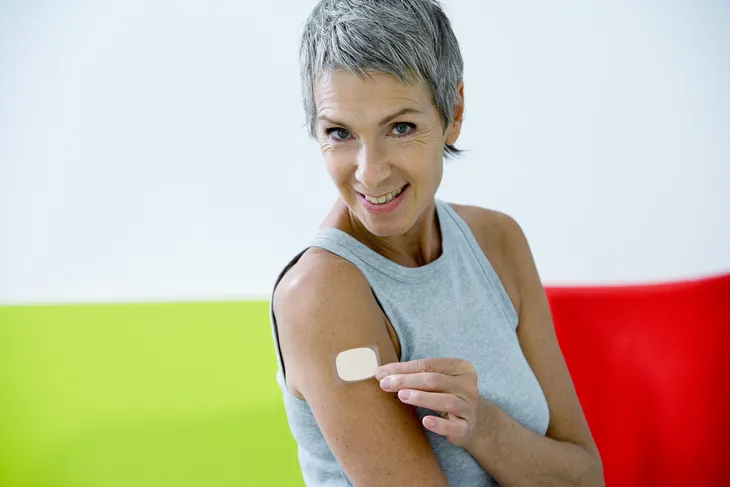There are many different hormones in the human body, but hormone replacement therapy typically focuses on replacing the hormones made by sex glands (ovaries and testes), which are estrogen, progesterone, and testosterone. As we age, our body produces less of these hormones which can create uncomfortable symptoms, particularly for women.
Menopause is different for every woman, but it tends to begin anytime after the age of 40 and continues into the decades following. Menopausal and perimenopausal symptoms don’t happen to every woman, and those that have symptoms can experience them in varying degrees, but for the most part menopause can come with hot flashes, poor sleep patterns, diminished libido, mood fluctuations, and low energy. The goal of hormone replacement therapy is to improve these symptoms.
Like many popular health topics, there is a lot of information available on the internet and some of it’s contradictory! So we’ve created an article that acts as a great place to start for any woman who is considering hormone replacement therapy. Here are some of the basic facts that every woman should know…
There Are Two Different Types
Before we get into much of anything, we should explain that there are two different types of hormone replacement therapy. The first is estrogen-only therapy (ET) which is used to treat menopausal symptoms, but is typically only ever prescribed to women who do not have a uterus. This would include any woman who has gone through a hysterectomy, says the North American Menopause Society (NAMS).
The second type of HRT is EPT which stands for estrogen and progestogen therapy. “Progestogen is added to ET to protect women with a uterus against uterine (endometrial) cancer from estrogen alone,” writes the source.
Systemic Hormone Therapy vs. Low-Dose Therapy
Now that we’ve covered the two types of hormone therapy (estrogen-only and estrogen and progestin), it’s also broken down into systemic hormone therapy and low-dose therapy. Systemic can come in the form of the pill, skin patch, gel, cream, or spray. This therapy is most effective for hot flashes and night sweats. “Estrogen can also ease vaginal symptoms of menopause, such as dryness, itching, burning and discomfort with intercourse,” says the Mayo Clinic.
On the other hand, local hormone therapies typically come in the form of cream, tablet, or ring and are most effective for treating vaginal and some urinary symptoms. They do so in a much lower dosage that is considered to be safer for certain women.
It Comes in Many Different Forms
The last break down of hormone replacement therapy that we need to discuss are the many different forms. As we previously mentioned, hormone therapy is accessible through pill, cream, gel, skin patch, spray, rings, and suppositories. Each form of treatment has it’s own advantages and disadvantages, as well as benefits and risks. To learn about this in more detail, check out our article Pros and Cons of Each Type of Hormone Replacement Therapy, but we’ll give a brief overview here.
Estrogen treatment in the form of pills is the most common hormone replacement therapy, according to WebMD. They are often taken once a day with food, but they can come with a more complicated schedule. This form of HRT has been the most widely studied, so there’s a lot of information on it! Estrogen pills are best known for reducing or resolving the symptoms of menopause, primarily hot flashes. They can also lower the risk of osteoporosis. The biggest downside is that they can cause an increased risk of blood clots, strokes, and when combined with progestin can raise the risk of heart attacks (mainly for women who have a history of cardiovascular events). Also, because they are synthesized through the liver, they are not recommended for people with stomach problems or a history of liver damage.
The next form of treatment are skin patches. There are many dosages available, including ones that have progesterone in it (Combipatch). The estrogen is absorbed directly into the blood, unlike the pill which is through the liver. Since they are worn on the skin, the biggest downfall is that the patient has to be wary about sun and heat exposure.
Next up, topical creams, gels and sprays are also applied directly to the skin and absorbed directly into the blood. The specifics of how they are applied vary depending on the product, but for the most part are applied to the arms or legs. The pros for this form are the same as the patch, but the con is that there hasn’t been as much research and because it’s applied topically, there’s a risk it can be rubbed off before it’s absorbed or that it can be transferred to other people, if not careful.
Lastly, suppositories, rings and creams are the most common for treating vaginal specific symptoms like dryness, itchiness, burning, or pain during intercourse. These forms of hormone treatment are applied directly to the vaginal area making them extremely targeted. Similar to the other forms, they are a low dosage so they don’t pose much risk for blood clots, cancer, or cardiovascular events, but as a downfall, they can’t treat hot flashes.
Concerns From Women’s Health Initiative Trial
Over 10 million American women were taking synthetic estrogen (most of them being Premarin or Premarin in combination with progestin, which is a synthetic form of progesterone) to treat their menopausal symptom. However, this number dramatically dropped in the early 2000’s. This is largely due to the findings of the Women’s Health Initiative (WHI). In 2002 the Women’s Health Initiative performed the first large-scale study on hormone replacement therapy and found that women taking the PREMPRO product were at an increased risk for heart disease, blood clots, breast cancer, and stroke. According to Philadelphia magazine, the results were so overwhelming that the study was prematurely ended. A new study by the Heart Estrogen Progestin Replacement Study (HERS Study) took its place and found that women who have a history of heart disease or heart problems in general, were at risk of having another cardiovascular event if taking synthetic HRT.
The results of these studies had a major impact on the industry and basically scared women away from hormone replacement therapy entirely. The source notes that millions of women ended their treatment but were left with nothing to take its place. Today, over 15 years later, there is much more research available for women and much of it states that the hysteria surrounding the 2002 WHI estrogen-progestin trial was misleading and misunderstood. Dr. Robert Langer, one of the lead investigators of a WHI vanguard site who was involved in the study told CMAJ that “the study results were not statistically significant for breast cancer harm,” or for heart attacks. The source goes on to write that the only significant findings were that HRT increased risk of blood clots and reduced hip fractures.
Langer also pointed out that there were many things wrong with the study making the findings inaccurate, like that the participants pre-existing diseases and treatments weren’t adjusted and that the findings about who it applied to was inaccurate. It was supposed to be focused on women over the age of 60, but somehow the reports ended up lumping in younger women. CMAJ writes that the trial was meant to focus on long-term therapy and only 30-percent of the participants were actually between the ages of 50 and 59 which is actually the most common age for HRT treatment.
Most Women Don’t Need It
According to Dr. JoAnn Pinkerton, executive director of the North American Menopause Society and professor of gynecology at the University of Virginia Health System, most women don’t need hormone replacement therapy. When talking to Healthline, Pinkerton said most menopausal women don’t need treatment. Not only that, but those who do, don’t need to take it for very long.
So what does this mean? Healthline explains that most women can take hormone replacement therapy within 10 years of menopause to treat their hot flashes and not have any concerns about their safety. “Also, estrogen in the vagina is an under-used safe remedy for other symptoms,” writes the source. However, all women should consult with their doctor about the risks and benefits in order to make a decision that is best suited for them.
There are Side Effects
Like most medications, hormone replacement therapy can have some side effects. While oral estrogen pills are best known for reducing the uncomfortable symptoms of menopause, they can also cause swollen breasts, vaginal discharge, headache, and nausea, says WebMD. Other less common side effects are fluid retention, headaches, skin discoloration, increased breast density which makes mammograms more difficulty and the patch can cause a skin irritation, explains the Cleveland Clinic.
It’s important to note that most women do not experience these side effects. In fact, the Cleveland Clinic points out that only about 5 to 10-percent of women do, and those who do experience them find them to be very mild. The side effects are never so severe that the therapy needs to be stopped. “If you have bothersome side effects from HRT, talk to your doctor. He or she can often reduce these side effects by changing the type of dosage of estrogen and/or progestin,” writes the source.
What Tests Should Be Done Before HRT?
Before any woman begins taking hormone replacement therapy, they should meet with their doctor and go over whether or not this type of treatment would be beneficial. While HRT is effective and safe, there are risks and the risks can be higher, as well as more serious for some women depending on their age and medical history.
You should meet with your doctor, review your medical history, have a full physical exam done, and then discuss the pros and cons of HRT. Part of this discussion will include whether the benefits outweigh the risks, and whether or not there are other alternative options available. Because HRT is such a controversial topic with a lot of misunderstood information out there, even with doctors, be sure to choose a medical professional who has the appropriate expertise on the topic and a current understanding of the research.
No Such Thing as “Natural” Hormone Therapy
Remember when fictional character Samantha Jones boasted about her natural hormone therapy from the Sex and the City 2 movie? While we sure do love our SATC, it was grossly inaccurate. Samantha talked about Suzanne Somers “natural” method of managing menopause by using compounded bioidentical hormones. The idea of using more natural therapies became popular after the 2002 Women’s Health Initiative, which we discussed earlier in the article, publicized all the risks of hormone replacement therapy.
The Huffington Post puts the record straight on whether these alternative natural therapies were legitimate. The reality is that these methods are not safer because they are actually unregulated by the FDA which means there’s no standardization for the products and no tests on the formulations, warns Huffington Post. In fact the terms “natural” is just a marketing term used by these companies to lure in women who are looking for “healthier” alternatives.
“There is no scientific evidence that custom-compounded bioidenticals are safer or more effective or more ‘natural’ than standard pharmaceutical bioidentical prescriptions. The only ‘natural’ hormones are the hormones being made by your body,” writes the source. In fact the North Menopause Society, which is a non-profit made up of scientists and clinicians advises women not to use these custom-compounded productions and instead stick to the well-tested government-approved products.
You Cannot Test Hormone Levels
You might hear of people testing their hormone levels or wanting to have their hormone levels tested, but the reality is that it’s not reliable. The way it’s typically done is through saliva or blood, but the Huffington Post writes that it’s not something that has been proven to be accurate through science. The best and only real way to treat symptoms is on an as needed basis.
The North American Menopause Society explains, “Salvia testing to determine if a woman has the ‘right amount’ of hormones has not been proven accurate or reliable. Even blood testing of hormone levels has the drawback that levels vary throughout the day as well as from day to day. More important, the desired levels in postmenopausal women have not been established. In addition, an individual woman’s physical comfort may not even be related to her absolute hormone levels.”
No Such Thing as “One Size Fits All”
As you’ve probably noticed by this point in the article that there are several benefits to hormone replacement therapy, and there many risks. While HRT is considered safe for some women, it’s also considered unsafe for others. There is no “one size fits all” model. In order to determine whether or not this form of therapy is appropriate and safe, the patient must visit their doctor and discuss the risks and benefits, and the benefits must outweigh the risks. It’s also based on personal preference.
To determine whether or not hormone replacement therapy is needed, “depends on the severity of symptoms, including hot flashes, night sweats, vaginal dryness and irritability,” writes Huffington Post. “Hormone therapy should be individualized, which may mean trying different doses and schedules, as well as different routes of administration.”













